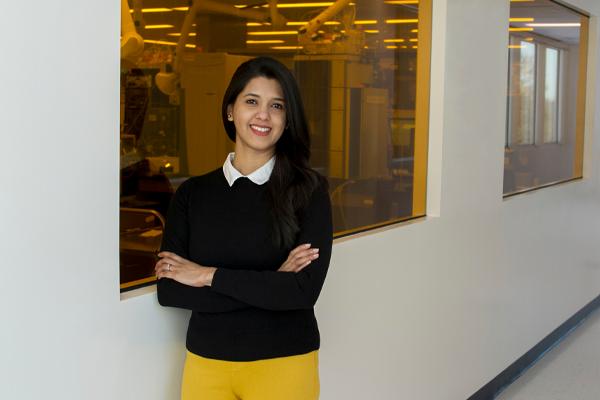By: Nina Notman

“My team develops automotive coating technologies for the paint that a body shop uses to repair a damaged car or customize a ride,” says Candice Pelligra. Cars typically have between four and six layers of polymer coatings over metal parts, each with a different function. “I work on the colored layer,” she explains.
Pelligra’s passion for polymers started during an undergraduate research experience while pursuing her bachelor’s degree in chemical engineering at the University of Connecticut. A PhD at Yale University with polymer physicist Chinedum Osuji followed. After graduation, in April 2015, Pelligra moved to Philadelphia to join ExxonMobil as a lubricants formulator. “I designed fit-for-purpose lubricants for everything from cars to offshore wind turbines,” she says.
Three years later, ExxonMobil moved her team to another campus. “I decided to stay behind in Philadelphia,” Pelligra explains. “While networking at a local ACS chapter event, I learned that Axalta Coatings Systems was relocating to Philadelphia at the same time that ExxonMobil was moving out, and I enthusiastically applied.”
In July 2018, Pelligra started her current role applying her polymer expertise to car coatings. “Designing coatings systems is surprisingly complex, and it is this complexity that is so energizing for me,” she says. “The colored coating must have great appearance, be compatible with a large variety of spray guns and painter styles, and provide long-lasting protection at low cost, all while meeting strict regulatory standards.” Ensuring compatibility with a broad range of possible chemistries that sit above or below the colored layer in a coating system is an additional challenge, Pelligra adds.
What's in your lab coat pocket?
I usually wear a disposable lab coat and unfortunately, they don't have pockets.
What is your favorite laboratory tool?
A fineness gauge. It’s a quick and easy way to check particle size as you go along.
What's the best part of your job?
The problem solving aspect. I love doing the detective work to better understand underlying physical and chemical phenomena that contribute to surprising new observations.
What’s the worst part of your job?
Many of our projects at Axalta R&D are forward looking. It’s easy for me to get excited about the materials and technologies I’m developing, but this means I don’t always have the joy of instant gratification by seeing them brought to market right away.
Who is your scientific hero?
J. Willard Gibbs. He's a hometown hero for me. He was born in New Haven, CT and spent his career at Yale, where I did my PhD. His contributions to the understanding of thermodynamics and physical chemistry underpin everything I work with day-to-day.
What’s the best piece of professional advice you have received?
To stay at the edge of your comfort zone. Once you become too comfortable with a project or a position, it's time to move on and to grow.
Do you have any advice for aspiring industrial chemists?
Participate in everything the ACS has to offer, especially the local chapters. I've been an ACS member for 10 years and the network has helped me numerous times in my career so far.
Where do you see yourself in 10 years?
I'd love to be a technical expert in some aspect of coatings in 10 years. I’ll also hopefully be serving as a mentor to people who are in my position now.
What's your favorite car color?
My favorite isn’t available commercially – it’s a test color I use in the lab. But, blue pearl is my favorite commercial color.
What do you like to do to relax?
I am a huge gardener. I also love to cook and preserve what I grow in my garden.
The opinions expressed in this article are the author's own and do not necessarily reflect the view of their employer or the American Chemical Society.
Copyright 2020 American Chemical Society (All Rights Reserved)









